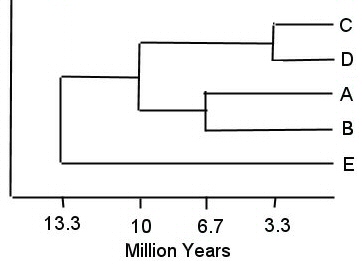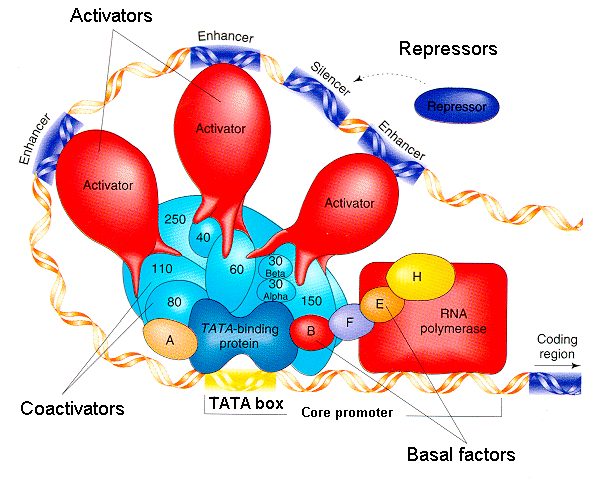BIOL 114 Test 3
November 10, 2006
Name ________________________________
Scores:
| 45-50 | A- to A+ |
| 40-44 | B- to B+ |
| 35-39 | C- to C+ |
| <35 | D |
|
1. (6 pts) Draw a chart of the evolutionary divergence of these five species. The table shows percent relatedness between pairs of species. Assume that these species mutate and diverge at 1.5% / million years.
Sample calculation: C-D divergence = (100-95%)/1.5% per million years = 3.3 million years
2. (6 pts) In evolution of genes, explain what is meant by orthologs versus paralogs. Explain an example of a pair of orthologs, and a pair of paralogs.
Paralogs
are genes in the same species that share the same ancestral gene, but
have evolved different functions in the same species. The Hox genes,
for example, serve different key roles in development, although all
evolved from a common ancestor. 3. (4 pts) For a restriction enzyme of sequence AA(Pur)(Pyr)TT, about how many cut sites would you expect in a genome of size 6 x 109 bp?
Average
spacing of sites = (4)(4)(2)(2)(4)(4) = 1024
4. (8 pts) Explain how the processes of gene cloning and PCR amplification are based on naturally occurring enzymatic processes in microbial genetics.
Gene
cloning involves cutting a plasmid and target DNA with a restriction
endonuclease, a type of enzyme made by bacteria in order to cleave foreign
DNA (such as from a phage) that endangers their survival. The plasmid
DNA incorporates the cleaved target DNA into its sequence by annealing
(hybridization) of its staggered ends, regenerating the restriction
site sequences. Completion of the recombinant plasmid requires use of
ligase to seal the phosphodiester backbone. Ligase is an enzyme used
by bacteria to seal the nicks between portions of the lagging strand
of DNA replication.
5. (6 pts) Sketch the structure of a recombinant plasmid, of the type found in the Plasmid program. The restriction enzyme data are shown:
EcoRI -- 3 kb, 9 kb PstI -- 1.5 kb, 10.5 kb BamHI -- 4 kb, 8 kb EcoRI + PstI -- 1.5 kb, 3 kb, 7.5 kb EcoRI + BamHI -- 1 kb, 3 kb, 8 kb PstI + BamHI -- 1.5 kb, 4 kb, 6.5 kb
6. (6 pts) Explain the structure of a drug-resistance transposon, including its essential genetic features.
A drug-resistance transposon makes its host bacterium resistant to an antibiotic drug. The transposon consists of a DNA sequence flanked by two inverted repeat ends, which pair up for recombination in a "stem-loop" during excision of the transposon. The DNA sequence must include a gene encoding a transposase enzyme to catalyze excision or copying of the transposon sequence; and a gene encoding an enzyme that deactivaes or exports the antibiotic drug.
7. (6 pts) For each partial-diploid for the lac operon, explain whether B-galactosidase is expressed, and whether lactose is needed as inducer, and why:
A.
The lacZ gene (lower operon) expresses B-galactosidase constitutively
(without requiring lactose inducer), because the operator fails to bind
repressor (expressed by lacI+).
Regulation of eukaryotic transcription requires: basal factors, protein complexes vthat enable RNA polymerase to transcribe from the core promoter; coactivators, protein complexes that connect the basal factors to the protein-binding domains of the activators; transcription factors (activators) that contain protein-binding domains to bind the coactivators, and DNA-binding domains to bind the enhancer sequences on DNA. Transcription can be repressed by repressors binding to silencer sequences.
|


